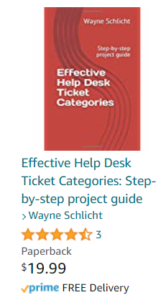
Most Help Desk and Call Center Managers understand that Help Desk ticket categories are a powerful organization tool. However, not all managers understand that Help Desk ticket categories are a prerequisite for many of the processes and tools the Help Desk relies on. It’s not enough to have Help Desk ticket categories they must be updated, revised, and accurate.
So what processes and tools are assisted by Help Desk ticket categories? Help Desk ticket categories are the primary tool for Help Desk Agents to set  the correct ticket priority levels. Without ticket category guidance, you will find Help Desk Agents all over the board with priority levels. Help Desk ticket categories can help present category specific just in time knowledge solutions and decision scripts, which is a terrific way to improve your Help Desk first contact resolution.
the correct ticket priority levels. Without ticket category guidance, you will find Help Desk Agents all over the board with priority levels. Help Desk ticket categories can help present category specific just in time knowledge solutions and decision scripts, which is a terrific way to improve your Help Desk first contact resolution.
Help Desk ticket categories are a manager’s best friend for detecting issues and building effective reports. Detecting reporting on issue trends can assist management in making decisions. These training, financial and staffing decisions can mean the difference between an average Help Desk and a truly world-class Help Desk. Are you getting the most out of your Help Desk ticket categories? We recommend downloading the Help Desk ticket category guide as your first step in maximizing your Help Desk program.
To make Help Desk ticket classifications the most effective, we identified some foundational principles for ticket management to ensure your process is the most effective.
Top 7 Help Desk Ticket Tips
- Tickets are mandatory – For all support interactions, a ticket documenting the support must be created as an official record. Many say if it is not documented in a ticket, it didn’t happen.
- Ticket documentation must be descriptive – Ticketing documentation must capture who, what, when, where and how. Each update to
 the status of the issue must be captured with specific detail of what occurred.
the status of the issue must be captured with specific detail of what occurred. - Ticket comments should identify the contributor – Each ticket update or comment should be associated with the contributor of the update or comment. This provides an audit trail to the historical record.
- No ambiguous classification terms – The ticket classification scheme should not include ambiguous terms such as other, miscellaneous, and issue.
- Continuous improvements – Ticket classification should improve efficiency not create overhead. Frequently reviewing your structure and process will improve efficiency.
- Use customer-centric operational categories – You should design ticket classifications that are based on the customer description of the issue captured by the Help Desk Agent during the initial contact. In most cases, obtaining detailed technical information on the issue from the customer over the phone is not a realistic expectation. Define ticket category terms based on customer terminology.
- Include resolution categories (closure codes) – Many companies have two ticket classification schemes called operational categories and resolution categories. Resolution categories are technical closure codes entered by the resolver team and are based on the resolution.
Leave a Reply